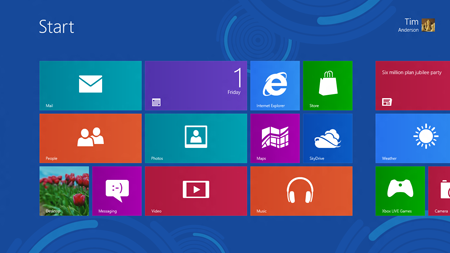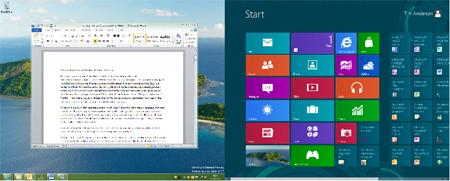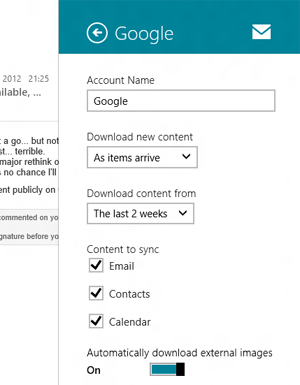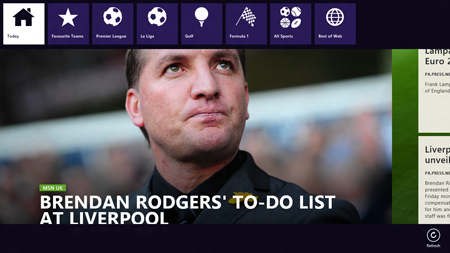Original URL: https://www.theregister.com/2012/06/01/windows_8_rc_review/
Windows 8: We kick the tyres on Redmond's new tablet wheels
Tastes like chicken
Posted in OSes, 1st June 2012 12:27 GMT
Review The surprising thing about the Windows 8 Release Preview just delivered is not how much has changed from February's Consumer Preview, or even the Developer Preview from September 2011, but rather how little.
Microsoft is set on delivering this hybrid tablet-and-desktop operating system pretty much as-is, despite widespread feedback that the concept is not quite working. Windows chief Steven Sinofsky expects the new OS to "enter the final phases of the RTM process in about two months". That means August or thereabouts to finalise the code, and pre-loaded machines on the shelves a couple of months later, in time for winter.
Windows 8 is a touch-first operating system that uses Microsoft's Metro design language, first seen in Windows Phone, on top of a new runtime layer which is designed for cloud and mobile. Apps are isolated from each other and from the operating system, and most users will install them only from Microsoft's store. Conceptually the old Windows desktop is just another app: tap it, and you are back in the familiar desktop environment.

Getting started on a Windows 8 x86 tablet
So what's new in the Release Preview? I installed it on two machines, a Samsung Slate with the correct touch screen size and a quad-core desktop with dual monitors.
Perhaps the biggest change is that Adobe Flash is now baked into Internet Explorer 10, even on the Metro side which Microsoft said would be free of plugins. Technically this is still correct. Microsoft has worked with Adobe to get Flash distributed with IE 10 and updated via Windows Update. This will work on ARM as well as x86 devices.
There is a catch though: Flash support only applies to sites on a compatibility list distributed by Microsoft.
I found Flash worked well on major sites, but not elsewhere. This is intended as a compatibility feature, not for the long-term. Nevertheless, this will be a selling point for Microsoft against the iPad, although with many sites now making special allowances for Apple's Flash-free tablet in their multimedia content this is not the big deal it once was.
What is odd is that Microsoft has not done the same for Silverlight, its own multimedia and application plugin. This is particularly strange given the extensive Silverlight dependence in Microsoft's own products, such as the recently released System Center 2012 which used the plugin for most of its web management consoles. Visual Studio 2012 has a dedicated tool, LightSwitch, for Silverlight applications.
IE 10 has some other new features. By default, IE has Do Not Track set to on. The value of this depends on whether a website behaves correctly; the W3C says:
Websites that track users across multiple first-party websites must check for the presence of the Do Not Track user preference. If a website detects that this preference is enabled, it must disable any tracking code or collection of data that can be used for tracking purposes, regardless of the level of identification of the user.
There is also a new feature called Flip Ahead that will let users advance to a specified new page by swiping rather than by clicking a link. This is designed for multi-page articles.
We did find some odd behaviour with Metro IE 10. For example, on some sites a download prompt would appear for a .swf (Adobe Flash file) and would not go away, whether you tapped Open, Save or Cancel. This is the kind of issue you can expect with a preview browser that lacks plugin support and should improve.
Next, Microsoft has improved multi-monitor support. This starts with new backgrounds designed to span two or more screens. More significantly, you can now display the Start menu on any display, which helps with usability since you can summon Start on the screen where you are not currently working. Another advantage of this arrangement is that you can run Metro apps without obscuring the primary screen with its desktop notification area, which we found annoying in the Consumer Preview.

Work on the primary display, Start on the secondary display - multi-monitor support
New Metro-style apps in the Release preview include News, Sports and Travel, good-looking apps that depend on Bing search to deliver content from the web in a swipe-friendly style. That said, the apps currently on offer in the Store are few and - in general - not compelling, considering their importance to the success of this project. There will be more for the final release, and they will need to be good to persuade desktop users that Metro is any more than a distraction.
The Mail, Calendar and People apps are enhanced compared to the Consumer Preview versions. The Mail app lets you specify how far back to synchronise your email, and whether to include contacts and calendar from each account.
Unfortunately there is still no option to forward an email.
I also had trouble connecting to Exchange, even with a fully patched Exchange 2010 server sitting on the local network in the same room. Exchange support depends on Autodiscover, a mechanism for automatically detecting emails settings via DNS, but even with Exchange reporting that Autodiscover was set up correctly, it did not work - presenting a typically uninformative message: "Unable to connect. Ensure that the information you've entered is correct." If in doubt, blame the user.
Desktop tweaked for Metro
Microsoft is tweaking the Windows 8 desktop to give it more of a Metro feel, with squared window corners and a more blocky style. The Aero theme in Windows 7 and Vista is being retired, according to Microsoft, but we will not see the final desktop theme until the final release.
Windows 8 Release Preview feels more refined than before. The Metro user interface is responsive and the best apps, such as Weather, work beautifully as you swipe through from quick overview to detailed historical charts from Wolfram Alpha. On the desktop side, Windows 8 feels faster than Windows 7, though that may be partly the effect of a new, clean install. Nevertheless, applications such as Office 2010 run sweetly.
Windows Release Preview does improve on the Consumer Preview three months ago, but does it fix those things that have most annoyed the Windows community? In general, no. Users have complained of the jarring effect of switching between the Metro-style Start menu and the desktop, and this still exists in the Release Preview.

New mail options: Google worked but Exchange failed
Further, the Start Menu still fills up with a mass of disorganised shortcuts as you install applications, since it does not reflect the grouping which existed in the old Start menu. "Digital Certificate for VBA Projects" installs with the same status as "Microsoft Excel". In practice, you find yourself developing Start menu avoidance strategies, like pinning every possible application to the taskbar. One welcome concession to desktop users is the Power Users shortcut list, summoned by right-click in the bottom left corner, which gets you the most frequently used utilities such as the Event Viewer and Device Manager.
Another common complaint is that typical Metro-style apps waste screen space. On a 1280 x 1024 desktop, for example, it seems odd that the SkyDrive app can only fit three rows of document shortcut icons in its default view. Go to the Detail view and you get nine. Touch-friendly, but for users equipped with mouse and keyboard this feels wrong.
A more fundamental issue is the lack of integration between the Metro side and the desktop side. This is by design, but it is also continually confusing, particularly with applications like IE 10 which exist in both environments.
Microsoft is committed to full-screen apps on the Metro side, as part of its "immersive user interface", but this itself is an annoyance. How difficult would it be to offer an optional status and notification bar to run across the top or bottom of the Metro UI? There is plenty of room for it.
The company's answer to this kind of criticism can be found in a post from Jensen Harris, director of program management and formerly a key member of the Office 2007 Ribbon UI team - a project that also ran into user opposition.
Harris describes how every new version of Windows has had vocal opponents, but that users are won over in time. "Although some people had critical reactions and demanded changes to the user interface, Windows 7 quickly became the most-used OS in the world," he says. Clearly Microsoft believes that history will repeat; though Harris conveniently forgets the warm reception Windows 7 won even in preview.

Sports app: Related content is aggregated in one swipe-friendly format
Will users be convinced by Windows 8? On the plus side there is excellent engineering here, both in Metro and on the desktop, and a user interface that really does work for touch users. The case against is that Microsoft is not listening to the feedback from even its most committed users.
A few relatively small tweaks, like the ability to run Metro in a window, would ease the transition, but Microsoft has taken the bold or foolish or obstinate (pick your favourite) decision to press ahead with its original design.
Microsoft will get this right eventually, even if it is not until Windows 9, and in the meantime Windows 7 is set for a long life. The company may not care much about that, since it is more concerned about competing with Apple's iPad. In this respect, the launch hardware from Microsoft's OEM partners will be critical, on ARM (WindowsRT) as well as on x86 - WindowsRT will only be available on the hardware, unlike on the x86 side.
The company has also announced an upgrade offer which means that users buying Windows 7 PCs after 2 June, 2012 will get an upgrade to Windows 8 at a nominal price. ®